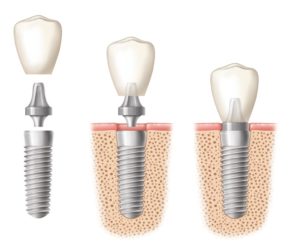
Whenever possible, we try to help patients save a natural tooth. This is why we recommend crowns or inlays (or onlays), which help protect a tooth’s structure. However, there are times when removing a tooth is necessary.
For example, if a tooth breaks below the gum line (often due to a fracture in the tooth or tooth many fillings), a crown can no longer save the tooth and it must be removed. Too, when gum disease has destroyed the foundation for tooth roots, removal of some teeth may be necessary.
Prior to removing the tooth, we try to help each patient determine the best way to replace it. Although you may be able to eat and speak with your remaining teeth, the absence of one or several teeth can create a domino effect of problems.
Each tooth is designed to abut the teeth on each side. This keeps it in alignment while it serves to also help neighboring teeth stay in their proper positions. Too, each tooth maintains its height by ‘meeting’ one above or below. Without it’s ‘match,’ it would grow longer.
When a natural tooth is missing, the surrounding teeth are no longer held in position. Teeth on either side will tilt out of place. The tooth above or below elongates. As these disparities occur, these teeth become vulnerable to breaks, chips or fractures since they no longer meet surrounding teeth properly while biting, chewing or speaking.
The preferred option for replacing a tooth is a dental implant, for a number of reasons.
First, an implant is held in the jaw bone just as the natural tooth was held. This means the replacement tooth will have the same, sturdy foundation as the natural tooth that was removed.
Too, the stimulation to the jaw bone from the implant prevents the loss of bone mass. This loss occurs when a tooth root is removed and leads to a process known as resorption. This is a ‘melting away’ of bone that can lead to a number of problems, including placing adjacent teeth at risk. An implant serves as a tooth root replacement and prevents this process.
The best time to place a dental implant, whenever possible, is at the time of tooth removal.
The removed tooth root’s depth and angle in the jaw bone is already ‘prepared’ to receive the implant. This minimizes the placement process and thus speeds healing time.
Additionally, the gum tissues that arch over a tooth and dip down a bit between teeth quickly begin to flatten without the presence of a tooth. Allowing the gap to remain for more than a day or so may lead to the need for gum reshaping to recreate this natural contour.
In our office, we provide comprehensive dentistry, offering care for virtually every dental need. While we offer all options of tooth replacement, dental implants are the closest thing to giving you a natural look, feel and function. And, they’re designed to last your lifetime!
Here, you’ll enjoy all phases of implant dentistry, with oral or I.V. sedation available upon request. Sedated patients are monitored by trained staff members who use advanced safety equipment to ensure safety and comfort.
If you’re facing the need to have a tooth removed, consider the ideal option of dental implants. And, take advantage of the one step ‘tooth-out-implant-in’ process that eliminates the need for more time in treatment and more healing time.
Begin with a free consultation. Call 586-739-2155 to schedule.